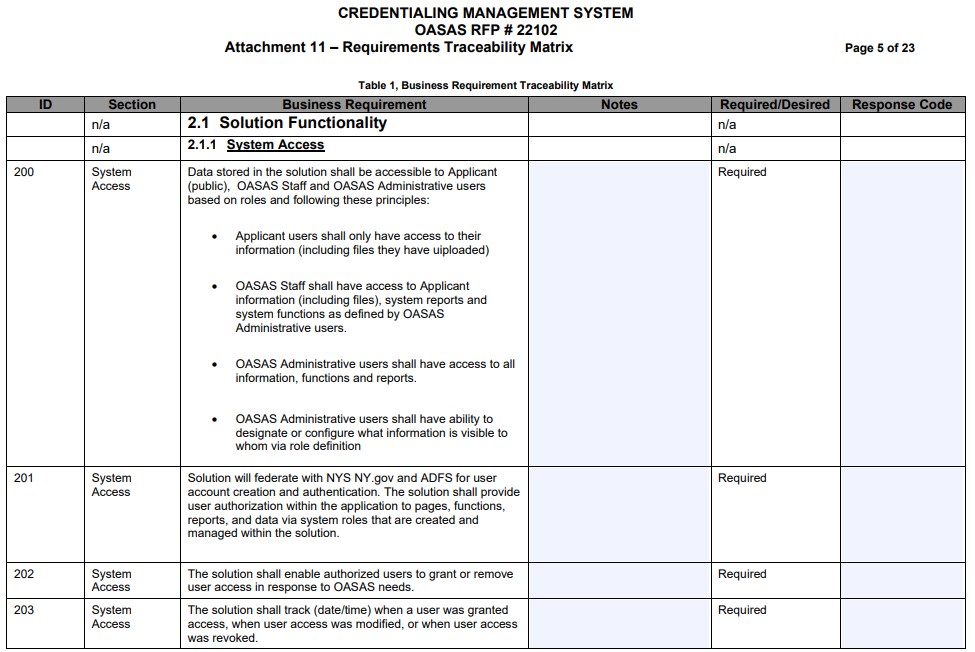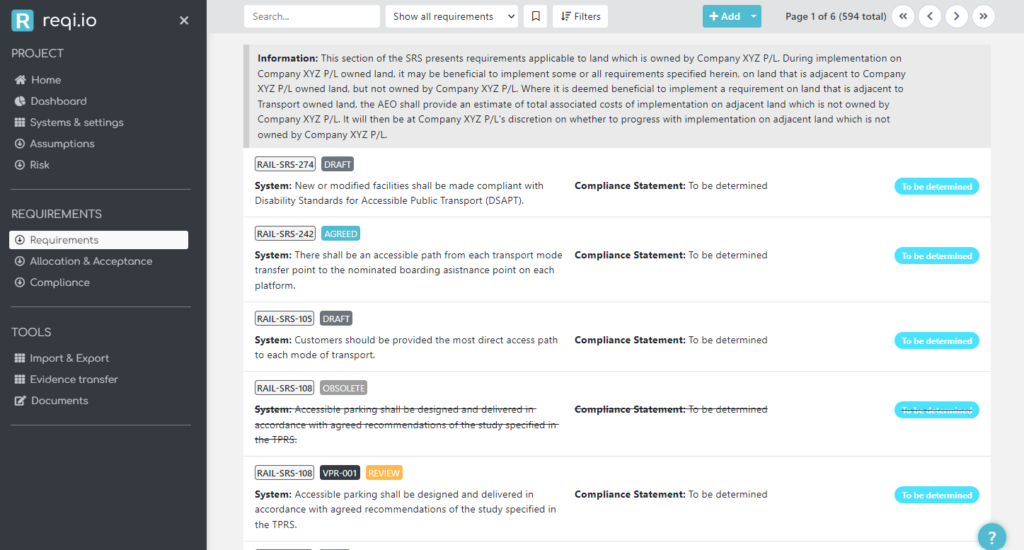A traceability matrix is a structured document or tool used in project management, software development, systems engineering, and other fields to track and ensure that requirements or elements from one stage of a project or system development process are linked to corresponding elements in another stage. It helps maintain traceability, which is the ability to trace and verify the relationships between different project or system components.
Table of Contents
- Key Aspects of a Traceability Matrix:
- Alternate Names for a Traceability Matrix
- Linking Traceability Matrix to Systems Engineering and Requirements Management
- Frequently Asked Questions
- What is a Requirement Traceability Matrix (RTM)?
- What is the Purpose of a Traceability Matrix?
- Can You Provide a Requirements Traceability Matrix Template?
- What Does a Requirements Traceability Matrix Look Like?
- Can You Share an Example of a Traceability Matrix?
- How Does a Traceability Matrix Fit in Agile Development?
- What Are the Benefits of Using a Traceability Matrix?
- Is a Traceability Matrix Used Only in Testing?
- How Do I Create a Traceability Matrix?
- Why is Requirements Traceability Important?
- Conclusion
- Experience the Power of Reqi – Try It for Free!
Key Aspects of a Traceability Matrix:
Requirements Mapping
A traceability matrix serves as a fundamental tool in connecting diverse project or system requirements to corresponding elements in subsequent development phases. It enables clear tracking of how each requirement progresses through the project’s lifecycle.
Bidirectional Traceability
Notably, an effective traceability matrix establishes bidirectional traceability. This implies it allows for both forward tracing, linking initial requirements to design specifications, code, and test cases, and backward tracing, facilitating navigation from these downstream elements back to the originating requirements. This dual functionality ensures thorough requirement coverage.
Change Impact Analysis
One of the matrix’s most valuable roles is aiding in change impact analysis. When project requirements undergo alterations, the traceability matrix swiftly identifies affected design elements, code segments, and test cases. This expedites the change management process and minimizes disruptions.
Quality Assurance
Central to the traceability matrix’s purpose is ensuring quality assurance. By providing a comprehensive view of requirement progression through development phases, it contributes to confirming that the final product aligns with specified requirements. This aspect is especially critical in industries with stringent quality and safety standards.
Project Management
Traceability matrices significantly impact project management. They allow project managers to monitor individual requirement progress as they traverse the development lifecycle. This facilitates assessing overall project advancement, identifying potential bottlenecks, and making informed decisions to keep the project on track.
Documentation and Compliance
Traceability matrices play a pivotal role in documenting the development process, especially in regulated industries. They provide an audit trail demonstrating how each requirement has been addressed and validated. This documentation is essential for regulatory audits and certifications.
Alternate Names for a Traceability Matrix
A traceability matrix is a versatile tool known by various names, depending on the context and industry. Here are some alternative terms for a traceability matrix:
- Traceability Matrix (TM): Commonly uses “TM” to stress its role in linking requirements and other project components.
- Requirement Traceability Matrix (RTM): Frequently abbreviates to “RTM,” emphasizing tracking requirements throughout projects.
- Traceability Grid: Highlights the structured grid’s format for linking requirements and other elements.
- Trace Matrix: Often calls it the “Trace Matrix,” highlighting its tracing and linking function.
- Requirement Mapping Matrix (RMM): May shorten to “RMM,” focusing on requirements mapped to project components.
- Compliance Matrix: Indicates compliance with standards, especially in regulated industries.
- Verification Matrix (VM): Commonly shortens to “VM,” emphasizing its role in verifying correct requirement implementation.
- Validation Matrix (ValM): Sometimes abbreviates to “ValM,” highlighting validation against specified requirements.
- Requirements Allocation Matrix (RAM): Frequently uses “RAM” to stress requirements allocated to project elements.
- Requirements Verification Traceability Matrix (RVTM): Often shortens to “RVTM,” focusing on requirements verification.
- Requirements Allocation Traceability Matrix (RATM): Commonly uses “RATM,” highlighting requirements allocation to project elements.
These terms are often used interchangeably and serve the same fundamental purpose: to establish and maintain traceability between requirements and other project components.
Linking Traceability Matrix to Systems Engineering and Requirements Management
- Requirements Traceability: Traceability matrices offer a structured approach to tracing and tracking requirements from their inception through the entire development lifecycle. This ensures comprehensive documentation and fulfillment of all requirements.
- Change Management: Changes to requirements are common in requirements management. Traceability matrices expedite change impact analysis, identifying affected requirements, design elements, and test cases, facilitating efficient change management while minimizing risks.
- System Development Lifecycle: Traceability matrices play a vital role in systems engineering by ensuring that system requirements are consistently met throughout the system’s entire lifecycle, preserving the system’s integrity.
- Verification and Validation: Systems engineering requires rigorous verification and validation processes. Traceability matrices assist in verifying that requirements are correctly implemented and validating that the final system performs as intended.
- Documentation and Compliance: Many industries demand strict documentation and compliance with regulatory standards. Traceability matrices serve as a valuable tool for demonstrating compliance, providing a clear audit trail that showcases how each requirement has been addressed.
Frequently Asked Questions
What is a Requirement Traceability Matrix (RTM)?
A Requirement Traceability Matrix (RTM) is a powerful project management tool used to establish and track connections between project requirements and downstream development phases.
What is the Purpose of a Traceability Matrix?
The primary purpose of a traceability matrix is to ensure that project or system requirements are consistently met and to provide transparency and control throughout the development process.
Can You Provide a Requirements Traceability Matrix Template?
Yes, you can find various Requirements Traceability Matrix templates online to help you get started with your own traceability matrix. These templates often include sections for documenting requirements, their sources, status, and traceability links.
What Does a Requirements Traceability Matrix Look Like?
A Requirements Traceability Matrix typically consists of a grid format that lists project requirements on one axis and related elements, such as design components or test cases, on the other axis. It contains traceability links that connect requirements to these elements.
Here’s an example of a simplified traceability matrix:

How Does a Traceability Matrix Fit in Agile Development?
In Agile development, a Requirement Traceability Matrix is a valuable tool for maintaining traceability between user stories, acceptance criteria, and test cases. It helps ensure that Agile teams stay aligned with project requirements throughout iterative development.
What Are the Benefits of Using a Traceability Matrix?
The benefits of using a traceability matrix include improved requirement management, change impact analysis, quality assurance, and compliance with industry standards. It also enhances communication and transparency among project stakeholders.
Is a Traceability Matrix Used Only in Testing?
No, while traceability matrices are often used in testing to ensure test coverage of requirements, they have a broader application in project management, including requirements gathering, design, and overall project monitoring.
How Do I Create a Traceability Matrix?
To create a traceability matrix, start by defining the project requirements, design components, or test cases you need to link. Then, use a grid or table format to document these elements and establish traceability links between them.
Why is Requirements Traceability Important?
Requirements traceability is crucial for maintaining alignment with project objectives, managing changes effectively, reducing risks, and ensuring that the final product meets stakeholder needs and expectations.
Conclusion
Traceability matrices offer versatility in creation, whether through spreadsheets, specialized software, or manual techniques. The level of intricacy within a traceability matrix adapts to the project’s scale and specific demands. Regardless of the chosen format, their central objective remains unwavering: guaranteeing the fulfillment of project or system requirements while delivering transparency and maintaining control throughout the development process.
In conclusion, traceability matrices are indispensable tools that help project teams maintain alignment with requirements, manage changes effectively, and achieve compliance with quality standards. Their adaptability and bidirectional traceability make them valuable assets in navigating the complexities of project and system development. So, whether you’re working on a software project, a construction endeavor, or any other complex undertaking, consider employing traceability matrices to enhance your project management capabilities and ensure successful outcomes.

Experience the Power of Reqi – Try It for Free!
Reqi is more than just an online requirements management tool; it’s your partner in streamlining all aspects of requirements management. With our user-friendly interface and comprehensive features, Reqi is designed for users of all proficiency levels.
Here’s why you should give Reqi a try:
- Online Traceability Matrix: Our integrated traceability matrix simplifies requirements management, providing a clear view of compliance and system-level insights. Say goodbye to scattered data.
- Visualizations at Your Fingertips: Reqi offers intuitive visualizations within a systems engineering tool, enabling you to track compliance effortlessly and gain a holistic view of your project.
- Simple and Easy Portal: We pride ourselves on a user-friendly portal that ensures a seamless experience for every user.
- Shared Common Data Environment: Collaborate effectively in a shared environment that fosters teamwork and knowledge sharing.
- Efficient Requirement Management: Reqi connects your teams directly to contract requirements, streamlining management and visualization of system architectures, requirement allocation, and compliance.
- Proactive Collaboration: Promote collaboration from day one, aligning expectations and goals to avoid delays and misunderstandings down the road.
Don’t miss out on this opportunity to transform your requirements management. Try Reqi today with our FREE trial and experience the efficiency, collaboration, and clarity that only Reqi can provide!








Comment on “What is a Traceability Matrix?”